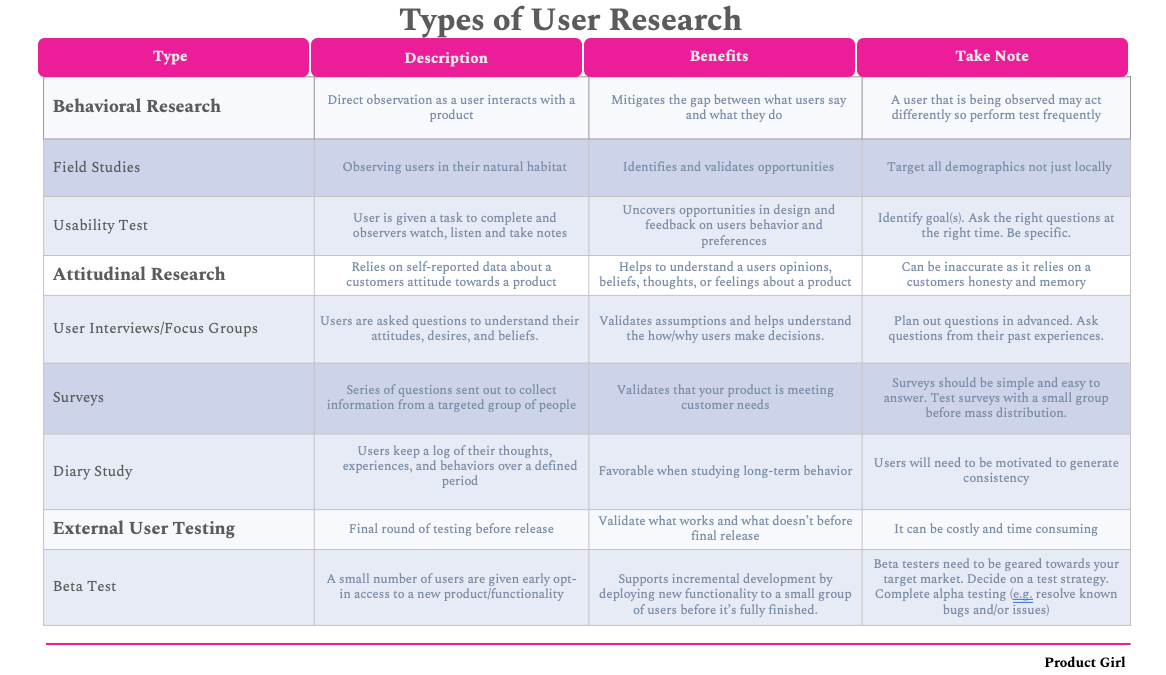User Insight = Qualitative Analysis = Why a user does something
In the past decisions were made based on intuition or studying up on product persona's. This was a problem because product decisions were made without ever talking to the customer. Assumptions weren't validated and even though people thought they understood their users, the truth is they didn't understand them enough. Making assumptions without validation always become large problems for customers later.
Developing user insight is a core skill as a product manager because understanding the needs of customers, their problems and validating that your solutions meet their needs is the beating heart of product management. This helps us build a product that gives them what they need.

Explore 👩🌾
Get to know current and potential users
In order to really understand customer needs and their problems you will need to talk to them. Not only will you need to speak to current users, but potential users as well. You can do this through focus groups or going out into the field and asking questions. Most likely you will have different types of users so if you can bucket them it will help validate feedback quicker and more accurately.
Having a genuine curiosity in their needs as opposed to just asking questions really goes a long way. Become aware of the words they use, their tone, mannerisms, and the way they answer questions. This is why I don't recommend surveys, e-mails or anything that doesn't provide live feedback in the discovery phase of a product. During live feedback sessions with users you have the opportunity to absorb emotional impact and ask follow-up questions in the moment. This helps to mitigate the process and understand their needs and problems better.
As you continually talk to users, focus on insights—both expected and unexpected– this will help you develop a greater awareness of your intuition. Keeping a log of what you think a user will say will allow you to get to know your current and potential users better so that you know when your intuition is right and when it can be wrong.
💁♀️ Tip: Knowing who your target market is beforehand will be beneficial when talking to customers. This will help to ask the right questions and to target users appropriately.
Develop a User Research Mindset
Most user research will be qualitative as opposed to quantitive because qualitative research helps you to better understand how the user makes their purchase as opposed to a quantitative metric that refers to the quantity of a product like a pricing component.
Quantitative research should be used when you want to confirm, test an assumption, theory or hypothesis. Qualitative research is used when you want to understand something like someone's thoughts, feelings or experiences about a product.

Investigate 🕵️♀️
Probe Deep and Clarify
Customers may think they know what they want, but that may not always be the case. Someone using a product will focus on how it affects them and how they feel about it not necessarily what the issue is. This is where you will need to develop probing skills as you will need to probe deeply into the customers needs. Once you have a better idea of what they need ask clarifying questions.
Clarifying questions are yes or no implied as opposed to probing questions that ask for more details.
Listening to calls, checking feature request, and talking to customers will be beneficial, but most importantly is being able to translate the customers needs into the correct solution. Digging deeper than the surface helps with this. For example, a customer may tell you that a webpage isn't user friendly, but why? Is it because it isn't responsive? Is it hard to navigate? Do pages on the site not load quick enough?
Understanding and digging beyond the surface level of a customers needs will help save time, effort, and money when building a solution. If you don't dig deep enough and get your 'hands dirty' then you may not actually solve the users pain points. One of the hardest things to accept as a PM is when you have built something that didn't solve the users core problem.
Tip: Probing questions should give users the opportunity to tell a story as opposed to yes/no answers. Stories pave the way to find out the 'why' someone is using a product, their goals, and where their priorities are.
Probing Questions
Probing Questions need to be centered around the problem you are trying to solve
- Tell me about how you use this feature today? What happens before you use it? While you are using it and after?
- If we implemented this new feature, but it meant that < tradeoff > how would you feel? (Tradeoff question)
- What are some of the challenges you encounter when using the product? How would you improve it?
- If we added this feature walk me through how you would use it?
- What is the most frustrating thing about the product?
- What do you wish you could do to the product that you can't do today?
At the end of the interview reiterate how you understand the issue and if there is anything you might've missed or should've asked about.
Be Insightful 🤔
Look into New Opportunities
As a PM you always need to be looking towards the future, but in order to help validate and expand your opportunities you need to understand what is happening in the world. This includes understanding your competitors, what's going on in the industry, and broader world changes.
A part of being a great PM will be to keep your finger on the pulse to ensure that your product is still delivering product-market fit and what you have in your roadmap is still viable for it's future.
Looking for new opportunities is the exploratory part of being a product manager. It's something that should be enjoyable and provide insight into the future of your product. Using various channels like market and user research helps to validate product-market fit.
Create a beginners mindset
When we understand something so well we get comfortable and forget that it was once new to us. Remember the first time you downloaded Instagram, Facebook or Snapchat? It took a minute to get used to its functionality.
As a PM when we know our product so well we can become overconfident and miss the learning curve a new user may experience. Practice putting yourself into the shoes of a beginner. How would you start? What confuses you? What are you trying to accomplish?
Build this skill by walking yourself back to when you first used the product. What did that journey look like for you? What problems did you encounter? If you don't remember or have trouble going back to the beginning that's okay. Seeing how users interact with the product in a live session such as HotJar can show you where in the customer journey they may be struggling.
Connect the dots
Be clear and obvious about how customer insights drive product decisions. Connecting the dots between product decisions and customer research will lay the foundation of a successful product by knowing what areas to focus on.
Customer insights help us to understand how users think and feel. Our intuition isn't always validated (it actually rarely is) and early in my product management career I relied way too much on 'what I thought' instead of 'what I know.' As I have progressed in my career I've come to understand that product decisions must be backed by user research.
"Customer insight, also known as consumer insight, is the understanding and interpretation of customer data, behaviors and feedback into conclusions that can be used to improve product development and customer support." - Tech Target
When working with executives and engineers they always have great ideas, but it's a rarity for them to be immersed in user feedback. Their areas of focus aren't to listen to calls, look over videos of user interactions, view heatmaps, or conduct interviews themselves. This is why the product manager will need to speak intentionally and with conviction when explaining their product decisions. It also helps to align these product decisions to user research and design.
Tip: Build and flex your intuition through extensive user research and observing patterns of behavior. Have retrospectives among your teammates to think, reflect, and discuss when things didn't go well. Discussing insights with your peers can help to validate and pivot when needed.
Develop an eye for usability 👀
10 Usability Heuristics for User Interface Design
- Visibility of system status: The system should always keep users informed about what is going on, through appropriate feedback within reasonable time.
- Match between system and the real world The system should speak the users' language, with words, phrases and concepts familiar to the user, rather than system-oriented terms. Follow real-world conventions, making information appear in a natural and logical order.
- User control and freedom Users often choose system functions by mistake and will need a clearly marked "emergency exit" to leave the unwanted state without having to go through an extended dialogue. Support undo and redo.
- Consistency and standards Users should not have to wonder whether different words, situations, or actions mean the same thing. Follow platform conventions.
- Error prevention Even better than good error messages is a careful design which prevents a problem from occurring in the first place. Either eliminate error-prone conditions or check for them and present users with a confirmation option before they commit to the action.
- Recognition rather than recall Minimize the user's memory load by making objects, actions, and options visible. The user should not have to remember information from one part of the dialogue to another. Instructions for use of the system should be visible or easily retrievable whenever appropriate.
- Flexibility and efficiency of use Accelerators — unseen by the novice user — may often speed up the interaction for the expert user such that the system can cater to both inexperienced and experienced users. Allow users to tailor frequent actions.
- Aesthetic and minimalist design Dialogues should not contain information which is irrelevant or rarely needed. Every extra unit of information in a dialogue competes with the relevant units of information and diminishes their relative visibility.
- Help users recognize, diagnose, and recover from errors Error messages should be expressed in plain language (no codes), precisely indicate the problem, and constructively suggest a solution.
- Help and documentation Even though it is better if the system can be used without documentation, it may be necessary to provide help and documentation. Any such information should be easy to search, focused on the user's task, list concrete steps to be carried out, and not be too large.
Final Words 📖
Remember your intuition will gradually improve as you progress in your career, but validating your feelings through credible conversations with current and potential users will help to avoid building a solution that doesn't solve the problem.
Also, when conducting user research don't take everything at face value. Study them and explore their pain points deeper. Chances are that what a person asks for may only solve a small part of the problem. This is when probing and digging deep is beneficial.
Lastly, don't rely on your assumptions and or intuition to make product decisions. User research comes cheap, but development does not. If you don't validate your hypothesis before you start working you can loose credibility and potentially cost the company money if your solution doesn't validate the customers needs.
Next Steps 🚀
1. User Insights
2. The Complete Guide to Research UX Methods
3. Data Insight